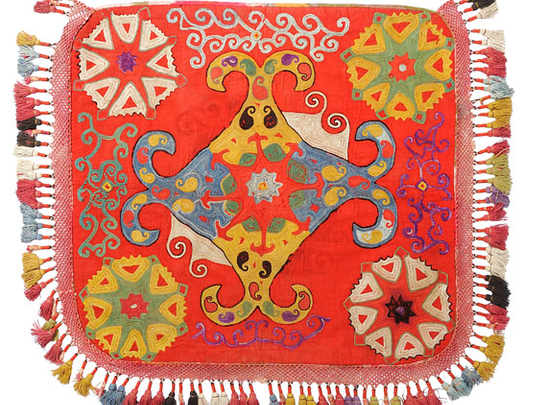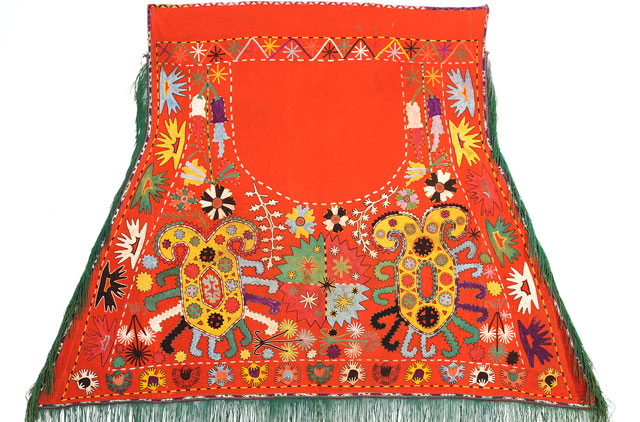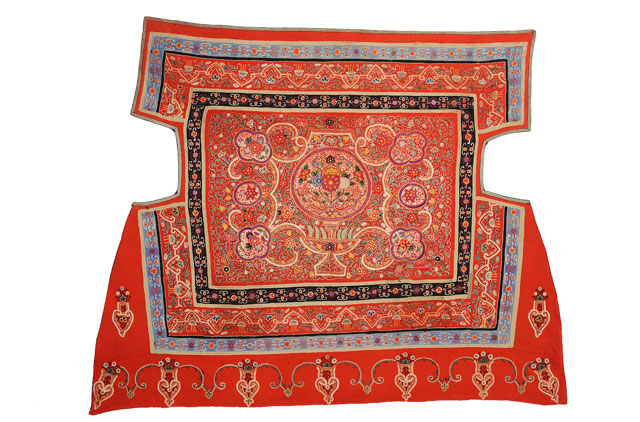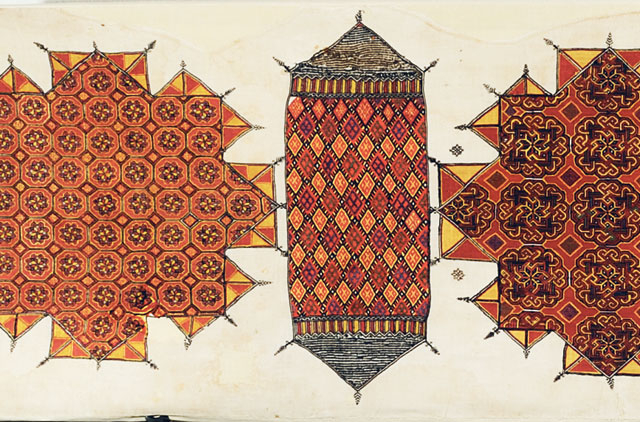
Since long and for many, the question of whether talent or skill contributes more to success is a controversial debate. Similarly, the phenomena of art and craft stands in opposition. At the ongoing exhibition of Islamic embroidery in Abu Dhabi, a veracious proposition on the growing curiosity about them can be gauged as the exhibits evidently unravel the intrinsic equivalence that exists between the powers of creation.
The region's first comprehensive exhibition brings together more than 200 remarkable textiles that date back from 17th century to the 20th century in relation to the magnificent tradition of embroidery carried on by urban, rural and nomadic women belonging to central Asia, North Africa and the Middle East.
"For centuries, embroidered textiles have occupied a major place in the social and commercial life of people living in these parts of the world," says curator Isabelle Denamur, who guides us through the exhibition. "It was part of the way they expressed themselves and bonded with each other.
"The art reveals much about their personalities, their position in society, their age and their geographical location. It is simultaneously a testimony of personal and social histories."
According to Denamur, textiles were ubiquitous in Islamic lands, playing an especially significant role in society, one that continued in subsequent periods. The cultural and aesthetic wealth had motivated the communities to create their distinctive styles that sustained regional, tribal and familial identities.
"Creativity was a source of great inspiration," Denamur says. The Andalusians influenced textile makers in Morocco; the Ottomans influenced artists in Algeria; and all across central Asia there was continual interchange among Mongols, Uzbeks, Pashtuns, Tajiks, Turkomen and others.
To make these historical and cultural links easier to grasp, the collection is ordered around two axes. The first is the organisation of embroideries by region and community. The second follows the theme of embroidery in nomadic and urban settings, where we see women as preservers of community tradition.
Despite the obvious diversity in style and function, what defines the characteristic quality and the apparent individual nature of the textiles is "beauty", which has its manifestation in Islam itself.
The legacy of fine craftsmanship involves the mastery of art and craft along traditional lines with meticulous attention to fine detail. Springing directly from the lives of diverse peoples across the Islamic world, every stitch, shade and pattern acts as a narrative description of past events and household stories. The feel of the fabric enkindles an intimate relationship with the history and culture hidden within these objects.
In the nomadic setting, embroidery played a key role in rituals, maintaining communal identity and protecting the family from evil. The pieces tend to be inspired by nature. On the other hand, urban populations of central Asia excelled in the production of large-scale embroideries called Suzani, specialised silk production and gold embroidery designed both for use within the community and as commodities to be sold. Suzani embroidery expressed the energy and beauty of spring in an oasis.
A collection of women's traditional costumes of the Turkoman community consists of simple shift dresses, flat caps, robes with embroidered trim and high-domed hats tufted with silver and feathers.
The highly abstract floral patterns of the robes represent tulips, a symbol of fecundity. We also find elek, a special bib-like garment worn by very young Turkoman children that was supposed to protect them from the evil eye and help them to grow strong, healthy and wise.
Women's dresses from the Mangal Pashtun, Swat and Kohistan regions of eastern Afghanistan and the Pakistan borderlands also express tribal identity.
The collection of men's costumes consists of Westernised vests and suit jackets with the traditional long, cotton shirt and baggy pants.
The horse-covers in the exhibition say something about how the Lakai and Kungrat Uzbeks view manhood. An ideal man in Lakia is he who is a cinchi, a spiritually-endowed, skilled master-of-horses and a warrior. Because manhood is closely identified with the tradition of the hero on horseback who defends tribe and tradition, horse culture and the making of elaborate horse decorations are important in many ceremonies.
Embroidered by women of the community and given by a father to his son, these horse-covers were prepared for celebrations of the passage of youths to adulthood. Highly abstract, eclectic renditions of single- and double-tailed scorpions are embroidered in silk on a wool.
Such powerful, even threatening, images are characteristic of Lakai ornamentation and reminiscent of the energy and high degree of abstraction found in the early animal-style art of the region.
Appliquéd wall hangings, stacks of colourful bedding, quilts, patch-worked felts, pillows, clothing bags and other decorating stuff used for nomadic dwellings known as yurt (tents) are also on display.
The collection is exceptionally rich in ilgich — small, square and pentagonal embroidered hangings. "Ilgichs are the most inventive, artistically powerful works made by Uzbek tribes," Denamur says. "They were embroidered by young Lakai and Kungrat women in preparation for marriage and brought as dowry into the new home."
In giving us a comprehensive view of history, Denamur says, throughout central and western Asia, women were expected to produce textiles for dowry and household decoration. They gathered in communal sewing groups called kashkar. Each would embroider a single narrow strip that was marked with the general pattern of the design.
Later, the strips were sewn together to form the completed piece. Men were also involved in commercial embroidery; guild workers produced hangings, kerchiefs and other items for export and sale in Russia and other foreign markets.
Embroidery from Morocco — confined mainly to Tetuan, Chechaouen, Fez, Meknes, Rabat, Sale and Azemmour — has its own distinct decorative principles. The underlying fabric in Moroccan embroidery is always matte white. For a good absorption of the natural dye, high-quality silk, such as "Hindi" silk was most often used. The tone of the colour depended on the length of time the silk yarn remained immersed in the colour bath.
"In contrast to central Asian example, embroidery in North Africa was a means for girls and women to escape confinement in the house and a way to express their feelings," Denamur says.
An expert embroidery mistress, the ma'allema, initiated young girls to this delicate art.
Once they had finished their work, the embroiderers met for tea. The finest examples of embroidery were then passed around so that each woman could make comments and express her admiration.
Other pieces on display also include Algeria's and Tetuan's tanchifa scarves and veils, characterised by decoration of Turkish, Syrian, Persian and Italian influences.
Women in their homes wore these light and transparent long scarves, which consist of long strips of elaborately embroidered muslin, during ceremonies such as marriages, circumcisions and religious festivals.
Often used as veils to cover the mirrors of the house to avoid the reflection of the "evil eye" during celebrations, each tanchifa was given an appropriate length and width. "The most fascinating aspect of the collection is that every piece is representative of a person, social group and time," Denamur says.
The exhibition exalts one's spirits to unimaginable heights. The reaction is partly the product of pent-up emotions that are stirred by a quest that oppugns the extent of human talent and scaling expertise.
The balance in composition of the motifs and the harmony and perfection of the design inspire awe to a point where one can assert the vitality and versatility of art in the 21st century that has moved away from the historic value of craft and documentation in favour of the "concept".
Layla Haroon is a UAE-based freelance writer.
A Story of Islamic Embroidery in Nomadic and Urban Traditions is on view in Gallery One at the Emirates Palace, Abu Dhabi, until September 25.















